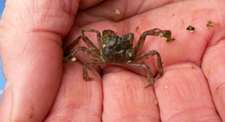Life history and migration behaviour
Mitten crabs are catadromous. That is, they spend most of their life in freshwater, but must return to the sea to breed.

A juvenille mitten crab in the palm of someone's hand
Growth phase
- Juveniles and subadults
- Lasts between 1 to 5 years
- Spent in freshwater (<0.5% salinity)
Reproductive phase
- Mating, spawning and hatching of larvae
- Occurs in higher salinities (2.6% or above)
- Crabs spend 8-10 months as sexually mature adults
Larval development
- Normally involves a prezoea stage, 5 zoeal stages and a megalopa stage
- Mitten crabs sometimes pass through an additional zoeal stage, possibly related to unfavourable environmental conditions
- Salinities between 1 and over 3% tolerated, although extremes cause increases in mortality
Migration
Males and females move downstream in large numbers during late summer and autumn, attaining sexual maturity when they reach the brackish water of tidal estuaries. Males arrive in the tidal estuaries first and mating occurs as soon as the females arrive.
After mating the females continue to migrate towards the sea and spawn in salinities of 2.6% or above. The adults of both sexes overwinter at sea, and return to the brackish estuary with egg hatching commencing in early spring. By late July this adult population has died off.
Larval development probably occurs in the lower estuary. Megalopas (the final larval stage) start settling out and moulting into the first crab stage and start the migration back upstream to freshwater.
Mitten crabs are able to migrate long distances: juveniles can travel around 1000km while growing to adult size.
The species has been found 1300km inland in China and 700-780km upstream in the Elbe River, as far as Prague in the Czech Republic.
Schematic representation of the catadromous life cycle of the Chinese mitten crab PDF (20.6 KB)
Toolbox
Glossary
Carapace
The shell that covers the head and thorax in many crustaceans.
